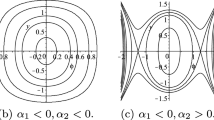Summary
This paper describes the effect of non-coaxiality arising from material anisotropy on bifurcation phenomena such as shear band formation. The elasto-plastic model originally proposed by Sekiguchi and Ohta [7] is one of the typical models which include anisotropy and it is used to examine the effect of anisotropy on shear band formation. First, we shall extend this elasto-plastic model for infinitesimal strain to a model for finite strain and discuss the mathematical structure of this model. The stress induced anisotropy is found to bring about a vertex-like effect, such as the non-coaxiality between the Cauchy stress tensor and a plastic stretching tensor, into the constitutive relation. Then, we shall examine the effect of this non-coaxiality on bifurcation conditions in relation to the material rigidity which changes with the angle of simple shear. Finally, it will be concluded that this non-coaxiality arising from the anisotropy does not contribute much to triggering instability by localization of the deformations which result in shear band formation, while on the other hand, the non-coaxiality due to the yield vertex effect is rather inclined towards instability by localization of the deformations.
Übersicht
Beschrieben wird der Einfluß anisotropie-bedingt verschiedener Achsen von Spannung und Deformationsgeschwindigkeit auf Verzweigungsphänomene wie die Scherzonenbildung. Das elastisch-plastische Modell von Sekiguchi und Ohta wird als typisch anisotropes Modell zur Untersuchung des Einflusses der Anisotropie auf die Scherzonenbildung benutzt. Zunächst wird es zu einem Modell für endliche Deformationen erweitert und seine mathematische Struktur erörtert. Es zeigt sich, daß die spannungsinduzierte Anisotropie einen Effekt ähnlich einer Fließortspitze erzeugt wie z. B. verschiedene Achsen von Cauchy-Spannungstensor und plastischem Strecktensor. Danach wird in Zusammenhang mit der Materialsteifigkeit, die vom Winkel der einfachen Scherung abhängt, der Einfluß verschiedener Achsen auf Verzweigungsbedingungen untersucht. Es wird gefolgert, daß anisotropie-bedingt verschiedene Achsen wenig zur Auslösung der Instabilität durch lokalisierte Deformation beitragen, andererseits verschiedene Achsen infolge einer Fließortspitze die Neigung zur lokalisierten Deformation unterstützen.
Similar content being viewed by others
References
Hueckel, T.; Maier, G.: Incremental, boundary value problems in the presence of coupling of elastic and plastic deformations: A rock mechanics oriented theory. Int. J. Sol. Struct. 13 (1977) 1–15
Ogden, R. W.: Non-linear elastic deformations, Chichester: Ellis Horwood 1984
Raniecki, B.; Bruhns, O.: Bounds to bifurcation stresses in solids with non-associated plastic flow law at finite strain. J. Mech. Phys. Solids 29 (1981) 153–172
Rudnicki, J. W.; Rice, J. R.: Conditions for localization of deformation in pressure-sensitive dilatant materials. J. Mech. Phys. Solids 23 (1975) 371–394
Sekiguchi, H.: Rheological characteristics of clays. In: Proc. 9th Int. Conf. on soil mechanics and foundation engineering, Vol. 1, 1977, pp. 289–292 Japanese Society of SMFE
Sekiguchi, H.: Theory of undrained creep rupture of normally consolidated clay based on elasto-viscoplasticity. Soils and Foundations 24, No. 1 (1984) 129–147
Sekiguchi, H.; Ohta, H.: Induced anisotropy and time dependency in clays. In: Proc. Speciality Session 9,9th Int. Conf. on soil mechanics and foundation engineering, 1977, pp. 229–239. Japanese Society of SMFE
Shibata, T.: On the volume change of normally consolidated clays (in Japanese). In: Annuals of Disaster Prevention Research institute, Kyoto University, No. 6, 1963, pp. 128–134
Yatomi, C.; Nishihara, A.: Principles of constitutive equations and expressions of anisotropy in soil materials. Soils and Foundations 24, No. 3, (1984) 15–26
Yatomi, C.; Yashima, A.; Iizuka, A.; Sano, I.: General theory of shear bands formation by a noncoaxial Cam-clay model. Soils and Foundations 29, No. 3 (1989) 41–53
Author information
Authors and Affiliations
Rights and permissions
About this article
Cite this article
Lizuka, A., Yatomi, C., Yashima, A. et al. The effect of stress induced anisotropy on shear band formation. Arch. Appl. Mech. 62, 104–114 (1992). https://doi.org/10.1007/BF00808733
Issue Date:
DOI: https://doi.org/10.1007/BF00808733




